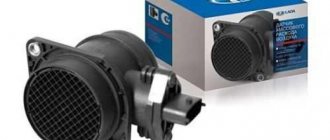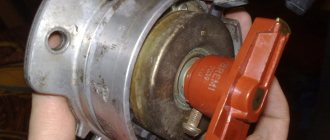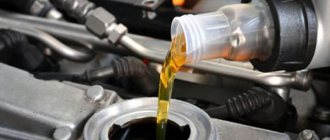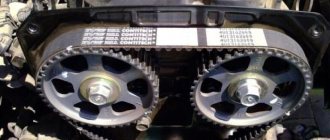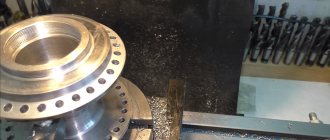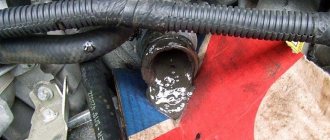Air recirculation in a car - what is it and why is it needed? Recirculation inside the car interior is the movement of air masses, including their heating or cooling, when air is not taken from the street for these purposes.
This is achieved by closing the damper, which draws in air from outside. This function can be very useful if, for example, there are old cars driving in front of you with increased dirty emissions into the atmosphere. In order not to pollute the air in the cabin, in such cases the air supply from the street is cut off.
Why is the recirculation function needed?
The damper closing functionality also helps save fuel resources when heating or cooling air. Since the difference in the initial temperature in the cabin compared to the set one (in the presence of an air conditioning system) has a smaller range and, accordingly, requires less energy consumption. When taking air from the street, it is more difficult for the car to heat or cool the air masses.
But few car owners use recirculation specifically for the purpose of saving; more often, drivers simply want to protect themselves from foreign odors around the car - this is the main factor when choosing this mode. However, like other car functions, recirculation has its positive and negative characteristics.
Pros of recycling
This feature helps solve some driver tasks in the most efficient way. The positive aspects of internal recycling are as follows:
- Fuel economy. Air masses that have a temperature in the cabin as close as possible to the desired temperature are easier to cool or warm up, since they have already passed through the dampers many times.
- Time to cool or warm up the interior. Also, taking into account the above point, the time required to lower or increase the temperature in the cabin becomes minimal, which is a convenient factor for the driver and passengers.
- Stopping the intake of air from outside helps people prone to allergic processes from pollen, dust and odors around the car.
- The main purpose of recirculation still remains to stop the entry of fumes and large dust accumulations into the cabin from the vehicle ahead, for example, an old KAMAZ.
Disadvantages of recycling
The air exchange mode with closed valves has disadvantages that are significant for many car enthusiasts:
- The main disadvantage is the lack of fresh air, since in the cabin you will use the same air, which is simply circulated throughout the car. This mode is not considered very useful from a medical point of view, so experts recommend activating it for a maximum of 15 minutes only if necessary, and then opening the dampers.
- Also, from a medical point of view, long-term inhalation of recycled air contributes to the activation of allergenic diseases.
- For normal vehicle operation and driver comfort, recirculation can become a hindrance, as it often leads to fogging of the windows in the cabin. To avoid these consequences, it is recommended to combine the operation of closed dampers with the air conditioner.
Where is the button and how to enable it
This functionality can have different types of activation depending on the type of vehicle, but according to standards it is customary to place the recirculation button on the front dashboard, next to the air conditioning control buttons. This button in most cases has a pattern made of an arrow, which is drawn in the form of a ring and is located inside the machine. When you press the button, internal air recirculation starts, and when you press it again it turns off.
Some models of domestic and other cars have a lever instead of a button that closes the door mechanically. If the car has climate control, there is an air recirculation indicator on the panel.
DIY seat ventilation
The above description of how the seat ventilation system works allows you to make a similar system with your own hands, based on the information received. In this case, seat ventilation can be installed in at least three different ways.
Installation of a ready-made kit (kit)
To do this, use a ready-made set of parts and assemblies that are commercially available, for example, as shown in the photo below:
Do-it-yourself installation of such a kit involves removing the seat trim, perforating it, as well as positioning and connecting the fans in the right places. As a rule, such a system has several speeds for regulating fan performance, which allows you to select the best option based on the current climatic conditions.
Article on the topic: Rating of the best MTPL insurance companies
DIY installation using individual elements
To perform ventilation yourself using individual elements, you need to buy:
- computer fans;
- plastic mesh instead of a spacer;
- buttons, wires.
Their installation begins with the seats being dismantled and the places where the fans will be attached are determined, then holes are cut out in the foam rubber for them.
In these places, excess foam rubber is cut off and instead of it, a cut mesh fifteen millimeters thick is laid.
After the mesh has been installed, previously cut foam rubber must be laid on top of it, in which holes with a diameter of one centimeter must be made.
The fans are connected by wires, the button for turning on the ventilation in the seat is located on the panel, or in any other convenient place.
Seat ventilation system using a car heater
You can do the blowing with your own hands without using fans. How this is done should be clear from the given figure and photo. With this approach, air from the stove is supplied to the seat using a corrugation. Such an air supply system will allow not only cooling, but also heating of the seats. It is best if the corrugation is installed inside the channel.
Why you can’t keep recycling on a constant basis
Constant use of this function can be harmful to the general condition of all passengers in the car, since the same air masses, constantly moving around the car, become damp. This may cause difficulty breathing for people inside the vehicle.
Additionally, the problem of glass fogging arises; many drivers spend a long time looking for the cause of such fogging and forget about the closed dampers. And the cause of this problem often lies precisely in air recirculation. Therefore, you can keep this mode active for no more than 15 minutes.
Typical faults
Subject to moderate use and careful handling, the service life is unlimited. Failure is caused by exceeding the permissible current, a short circuit in the circuit, and the negative consequences of an accident or shock.
In practice, there are cases of poor contact between the block and the terminals, blown fuse, and mechanical damage.
Don't forget to periodically ventilate the interior. Every second technical inspection, replace the cabin filter and troubleshoot the external air supply channels.
Video: Air recirculation, how it works.
Source
Air supply system on gasoline engines
The air supply design on gasoline injection engines is made up of the following components:
- air intake;
- cleaning, filtration element;
- inlet pipe;
- throttle fitting;
- receiver.
The air intake is used as a mechanism that draws air from the atmosphere into the engine. The air filter itself is located at the end of the engine compartment and is equipped with a mass fuel flow indicator.
The throttle body has a throttle position indicator and an idle speed control. It is the latter that regulates the amount of air masses that flow through the pipeline when the throttle valve is closed.
If you can't do it, fake it!
A functional air intake is expensive and creates certain disadvantages in the operation of the vehicle. Moreover, the modest increase in performance that a work bucket can provide is of more interest to racers than to the average car enthusiast. Therefore, it is not surprising that a significant number of cars with sports shapes are equipped with... imitation racing buckets! Fake buckets often have the most tangential relationship to the real thing and are usually installed where stylists thought they would look cool rather than where they would make functional sense. (This is especially obvious in vehicles that offer function buckets as an option; work buckets are often in different locations and have very different shapes.)
After all, sometimes it's more important to look fast than to go fast.
Source
Air supply system on diesel engines
The standard equipment of diesel engines is a turbocharger. Here the following components take part in organizing air circulation:
- filtration air purifier;
- air intake;
- turbocharger;
- air heat exchanger;
- inlet pipeline.
The air masses are launched into the turbocharger and then pass through the heat exchanger. The air enters the intake manifold, and then into the engine cylinders. The turbocharger uses the energy of recycled gases.
The air is released into the atmosphere using an exhaust structure. Modern diesel cars have begun to incorporate a throttle valve, which was not included in the design previously.
Six types
Science begins where classification begins. Well, let's get down to classification. Air purification systems are divided, firstly, by the number of cleaning stages (one-, two- and three-stage); secondly, by the method of collecting dust. In the latter case, six types of systems are distinguished.
1. Dry inertial with collection of separated dust into a hopper.
2. Dry inertial with dust suction from an external source.
3. Dry inertial with the release of dust into the atmosphere.
4. Inertia-oil.
5. Using filter elements with oil-moistened packing.
6. Using dry filter elements.
The first three types are mainly used in two- or three-stage cleaners on trucks and tractors. The fourth type was described in the previous section - this is already part of history. As for elements with wetted padding (type five), they are used mainly on expensive or sports cars. But the sixth type is the most popular, most in demand
Let's focus on him
How to increase air flow into the engine
It is clear that with an increase in air entering the motor, its power characteristics improve. Therefore, some car enthusiasts are thinking about how to increase this volume. Let's look at some options.
- For foreign brands of cars, a good solution would be a filter device with zero resistance, which is installed on the car.
- Additionally, work can be done to improve the air intake, pipelines and air filter cover to reduce resistance.
- There is an option to connect an electric fan to the intake mechanism.
- Sometimes auto repairmen remove an air intake from the hood to lower the temperature of the incoming air masses.
Ventilation system with recirculation mode
This mechanism operates according to this scheme, atmospheric air masses enter the cabin through a separate passage. Which then go into the hood structure, partly outside the car, and partly into the mixing cell. The existing air is mixed with new intakes, enters the air conditioner, and then again into the cabin.
For optimal cabin air quality, you should adhere to the following recommendations:
- The amount of air from the atmosphere must correspond to at least 10% of the capacity of the supply system;
- The volume of harmful impurities in incoming air masses should be no more than 30% of their concentration, which meets the standards.
Ventilation system with heating and recirculation
With this operating system, cooled atmospheric air enters the car, where it is mixed with warm air masses, and then in a mixed form enters the cabin. In this case, the nodes function as follows:
- the supply and exhaust fans are activated;
- the supply, exhaust and recirculation valves are open, each in accordance with the settings for the required supply of air masses;
- heating is on.
Turning on the air conditioner
When turning on the air conditioning system, you must first turn it on to the minimum mode (Low). After all, every system in a car needs a little work before it begins to function more efficiently. You won’t like your friends waking you up in the middle of the night and forcing you to run quickly across some terrain..(?) Likewise, the air conditioning system will not work effectively if it is immediately initially turned on at 100% power. If your car is equipped with an automatic air conditioning mode, then when you turn it on, the system itself will first operate at the minimum mode, and then gradually increase the blowing power.
Ventilation recirculation without heating
At higher air temperatures, the air masses entering the cabin do not necessarily have to undergo a heating period. The task in this vein is reduced only to the supply of outside fresh air, so heating in this case is not necessary.
The car components are configured as follows:
- the supply and exhaust fans are activated;
- the recirculation valve opens slightly according to the required temperature of the incoming air;
- the incoming air shutter closes according to the required incoming air temperature;
- heating is turned off.
For the air conditioning mechanism, this mode is suitable for any season. The air supplied inside must be in the above volume.
Heating system
In some models, the air heating system works when the air mass passes through pipelines that contain hot liquid. This design is complemented by fans that move air when the machine stops or moves slowly.
Thermal control options in cars.
Heating design with water valves.
In a heating system where water valves are present, air flows through the pipes. The temperature of the pipelines is regulated by the volume of hot liquid that moves through them.


